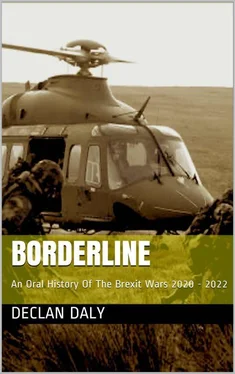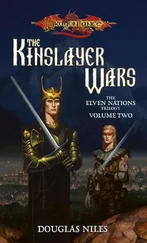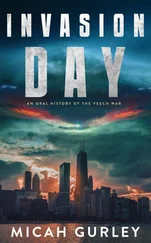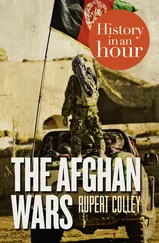Comdt Dave Healy
‘I mean, apart from the proximity and the timelines, it was the planning restrictions that put us in the crosshairs for this job again. The UK knew they were rowing back,politically, so they couldn’t let us go in too strong – as busy as we were, you couldn’t miss the news coming out of Westminister. Humanitarian or not, this was not a popular decision to let us in. At the very least, it was being used as a stick to beat the government, at best there was a ‘why aren’t we doing this ourselves’ mood. Either way, we were left with some bitter pills to swallow on our end.
The first was numbers. We could bring as many softskin vehicles and drivers as we wanted but in terms of security – fighting troops – we were limited to a battalion. So that was anyone in a Mowag or the back of a heli. Air was the next thing – no fighters. I think the French were happy enough about that, bombing Carsonites attacking in Ireland is one thing, but bombing UK passport holders in Northern Ireland? Whole different political deal. Almost as bad was that we could only use our own helicopters to insert and extract. No recce machines and no reinforcing or manouvering units if we got into trouble.
The last problem was the biggest in the end, from crossing the border to go in to the last soldier leaving we had a time limit of forty eight hours. This was a late addition to the restrictions to take some of the heat out of the UKs’ domestic optics on this. After that apparently we would be viewed as an invading force and dealt with accordingly. That was the statement in parliament anyway, although I doubt if it had been run by the MoD prior to that to see if it was realistic. It might as well have been tweeted. The time thing. Jesus, from the first look at the whole thing, to do it right we would’ve needed at least seventy two hours in theory and probably more in practice. Now it was going to be rushed. Relying on speed will only carry the day so far…
In terms of our troops, technically it was all still Task Group Viking, in practice we had left people shoring up Donegal airport, there were still troops in the field properly cleaning out Donegal – we still hadn’t assured ourselves that all the Carsonites had gone by that stage – we had people everywhere. We ended up with the TG Viking HQ, two of our own Companies, one reservist Company and holes filled by whomever 28 Bn could provide. As much softskin transport as we could get was brought up to Finner and then we had a grand total of five Mowags. That was all that we could spare from 2 Cav. After all that fighting, look people forget that these things are just machines and they break down, especially if you keep shooting them with stuff. It wasn’t much, but it was what we had. So the plan was, we would insert a Company plus the HQ by Chinook and the rest would drive in From Finner, through Beleek and along the A46 to Camp Erne. That bit went ok. Everything else went to shit the moment we stepped off the heli…’
◆◆◆
On arriving at Camp Erne, Comdt Dave Heallys’ A Coy, Task Group Viking were immediately struck by two things. One, there was many more people than initially planned for. Instead of the eight hundred they expected, the small camp was crowded with one thousand seven hundred and forty two men, women and children of all ages. The second was that the camp was in the middle of a major cornavirus outbreak, with as many as four hundred symptomatic ‘active’ cases being quarantined in a corner of the portacabin and tent based camp. Approximately eight hundred of the people there had been vaccinated, leaving five hundred people who had to be considered as having been exposed to the virus. With shared sanitation and feeding blocks, everyone had to be considered a close contact and simply tracing the indivuals a patient may have been close to was imposiible.
Doing the sums, each Chinook in a casevac role could only take twenty four stretchers, each AW139 could take four. These numbers reduced considerably when the patients needed critical care en route. Further complicating the issue was that these patients could not just be brought straight to an Irish hospital or refugee camp across the border – the numbers would simply overwhelm the existing facilities. The request for more time and helicopter movements was relayed up the line. The response was helicopter movements yes, time no. As the first elements of the ground convoy rolled into the camp, the first Chinooks were also landing to begin what became a non stop rolling medevac mission lasting until the end of the operation.
Comdt Brian Rafferty AC Ret’d
‘We knew there’d be casualties that needed to go by air– IDP camps aren’t exactly known world wide for conditions that produce athletes are they? So we were prepared for a certain amount of sick and injured, but when we were told to move four hundred active Covid-19 patients and another five hundred suspect cases to the Glen? Everyone knew that was impossible in the time we had. But, you know, we got to it and did as much as we could. It meant throwing everything we had at the task, the original plan went out the window, machines were pulled off maintenance where they could be put back together, crews were called in off rest, everything. At one stage, we had four Chinooks and six AW139s just shuttling people out.
Initially we took them to the Glen where our own new field hospital had been set up, and they were being packaged off by road and another two AW139s from there to hospitals around the country. This was too slow, but once the whole operation had been approved, the Germans had offered another field hospital and two CH 53 helicopters to move people. This was set up in Finner and with their helicopters now doing the shuttling within Ireland as well as our own, we actually managed to make quite a difference. We would land, load up stretchers, take them back to Finner, offload rotors running and then the Germans would move those that could be moved as quickly as possible to the Glen. After the first few runs, we were running out of stretchers so we kept the ones we had in the aircraft and just loaded people on bedsheets, roll mats – whatever they could be carried in. We actually moved the four hundred or so active cases quicker than we thought, some of them were effectively walking wounded.
After that, we had to pause, strip out the machines and sanitise them and then go back into get the suspect cases – we didn’t want to start a new pandemic by bringing people who only might be normal sick into an infected environment. We were also running out of fuel in Finner itself – the fuel farm there had been expanded underground but all those helicopters go through a lot of juice. While that was being refilled by trucks coming up from Baldonnel, we also flew in fuel cells with one of the Chinooks, just to keep us going. We refitted all the helicopters with seats and we half expected things to speed up significantly. Civilians aren’t troops though, and getting them loaded just seemed to take an age. In some cases helicopters would orbit overhead, waiting for space to land at the camp and then have to head back to Finner empty, just beacuse it took so long to get people organised and onto the machines. We got it done though, and even moved a few loads of the vacinated IDPs as well, so I think the ground troops only ended up having to move around five hundred in the end. But it kept going for the duration – the last heli left the camp at the same time as the trucks.’
Cpl Diane Keane
‘For all the time we’d been at war, it sounds stupid now, but our focus had always been on protecting Ireland, stopping it all coming south. We nearly forgot, or it was put to the back of our mind what we were protecting the place from? We forgot that the people just up the road from us really were getting hammered worse than any unit in the DF. It was a real shock when we pulled into the camp that first morning. The PSNI guys meeting us, they looked like they were happy just to be handing over some of the burden around the place. They were holding it together pretty well under the circumstances, but you could see the strain on their faces. Young men and women looking older than their years. Maybe they thought the same about us.
Читать дальше












